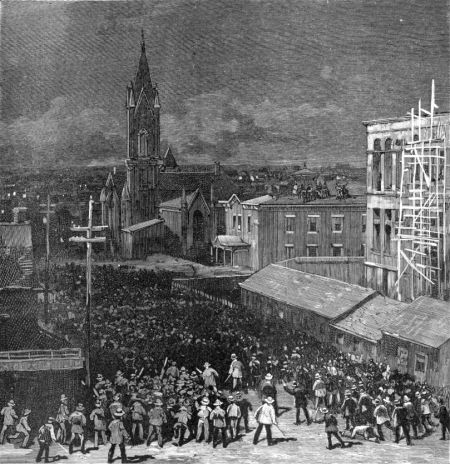Hawes riot: Difference between revisions
(Created page with "The '''Hawes riot''' was a major event in early Birmingham which occurred on the evening of December 8, 1888 when a mob estimated at two-thousand people converged ...") |
No edit summary |
||
| Line 1: | Line 1: | ||
[[File:1888 Hawes riot.jpg|right|thumb|450px|Illustration of the Hawes riot in ''Harper's Weekly'']] | |||
The '''Hawes riot''' was a major event in early [[Birmingham]] which occurred on the evening of [[December 8]], [[1888]] when a mob estimated at two-thousand people converged at the [[Jefferson County jail]] on [[21st Street North]], many hoping to take accused [[Hawes murders|murderer]] [[Richard Hawes]] out of the [[Jefferson County Sheriff's Office|Sheriff's]] custody and [[List of lynchings|lynch]] him. | The '''Hawes riot''' was a major event in early [[Birmingham]] which occurred on the evening of [[December 8]], [[1888]] when a mob estimated at two-thousand people converged at the [[Jefferson County jail]] on [[21st Street North]], many hoping to take accused [[Hawes murders|murderer]] [[Richard Hawes]] out of the [[Jefferson County Sheriff's Office|Sheriff's]] custody and [[List of lynchings|lynch]] him. | ||
The size and character of the mob was influenced by the fact that news of Hawes' arrest rippled through the city's taverns late on Saturday evening, just hours after [[Emma Hawes|his wife's]] body had been dredged up from [[Lakeview Park]]. | The size and character of the mob was influenced by the fact that news of Hawes' arrest rippled through the city's taverns late on Saturday evening, just hours after [[Emma Hawes|his wife's]] body had been dredged up from [[Lakeview Park]]. | ||
[[Birmingham Police Department|Police]] [[List of Birmingham police chiefs|chief]] [[A. O. Pickard] and Sheriff [[Joseph S. Smith]] warned the advancing mob to halt several times. Ultimately Smith ordered a volley of shots into the mob from the prison guards stationed on the roof with rifles and shotguns. The fusillade, sometimes mistakenly attributed to a Gatling gun, killed ten men and injured 30 others, but did succeed in dispersing the mob. Among the dead were postmaster [[Maurice Throckmorton]], a deputy U. S. Marshal, a civil engineer and a painter. | [[Birmingham Police Department|Police]] [[List of Birmingham police chiefs|chief]] [[A. O. Pickard]] and Sheriff [[Joseph S. Smith]] warned the advancing mob to halt several times. Ultimately Smith ordered a volley of shots into the mob from the prison guards stationed on the roof with rifles and shotguns. The fusillade, sometimes mistakenly attributed to a Gatling gun, killed ten men and injured 30 others, but did succeed in dispersing the mob. Among the dead were postmaster [[Maurice Throckmorton]], a deputy U. S. Marshal, a civil engineer and a painter. | ||
The next day, [[Alabama National Guard]] officer [[Thomas Jones]] was given command of thirteen militia company by [[List of Governors of Alabama|Governor]] [[Thomas Seay]] and charged with restoring order. Governor Seay also traveled to Birmingham to hear the city's plans to repair its reputation for lawlessness. Jones had Chief Pickard and Sheriff Smith arrested for murder, but both were freed after juries deadlocked, and served the remainder of their terms. | The next day, [[Alabama National Guard]] officer [[Thomas Jones]] was given command of thirteen militia company by [[List of Governors of Alabama|Governor]] [[Thomas Seay]] and charged with restoring order. Governor Seay also traveled to Birmingham to hear the city's plans to repair its reputation for lawlessness. Jones had Chief Pickard and Sheriff Smith arrested for murder, but both were freed after juries deadlocked, and served the remainder of their terms. | ||
Revision as of 13:09, 25 May 2020
The Hawes riot was a major event in early Birmingham which occurred on the evening of December 8, 1888 when a mob estimated at two-thousand people converged at the Jefferson County jail on 21st Street North, many hoping to take accused murderer Richard Hawes out of the Sheriff's custody and lynch him.
The size and character of the mob was influenced by the fact that news of Hawes' arrest rippled through the city's taverns late on Saturday evening, just hours after his wife's body had been dredged up from Lakeview Park.
Police chief A. O. Pickard and Sheriff Joseph S. Smith warned the advancing mob to halt several times. Ultimately Smith ordered a volley of shots into the mob from the prison guards stationed on the roof with rifles and shotguns. The fusillade, sometimes mistakenly attributed to a Gatling gun, killed ten men and injured 30 others, but did succeed in dispersing the mob. Among the dead were postmaster Maurice Throckmorton, a deputy U. S. Marshal, a civil engineer and a painter.
The next day, Alabama National Guard officer Thomas Jones was given command of thirteen militia company by Governor Thomas Seay and charged with restoring order. Governor Seay also traveled to Birmingham to hear the city's plans to repair its reputation for lawlessness. Jones had Chief Pickard and Sheriff Smith arrested for murder, but both were freed after juries deadlocked, and served the remainder of their terms.
References
- West, Goldsmith B. (1888) The Hawes Horror Birmingham
- "The Trouble at Birmingham" (December 22, 1988) Harper's Weekly. Vol. 32, No. 1670, p. 988
- Northrup, Jeff. (1978) "The Hawes Riot: All the News Unfit to Print" Journal of the Birmingham Historical Society. Vol. 5, No. 4, pp. 16-25
- Northrup, Jeff (1979) "The Hawes Affair, Part II." Journal of the Birmingham Historical Society. Vol. 6, No. 1
- Hoole, WIlliam Stanley (1980) The Birmingham Horrors. Huntsville: The Strode Publishers
